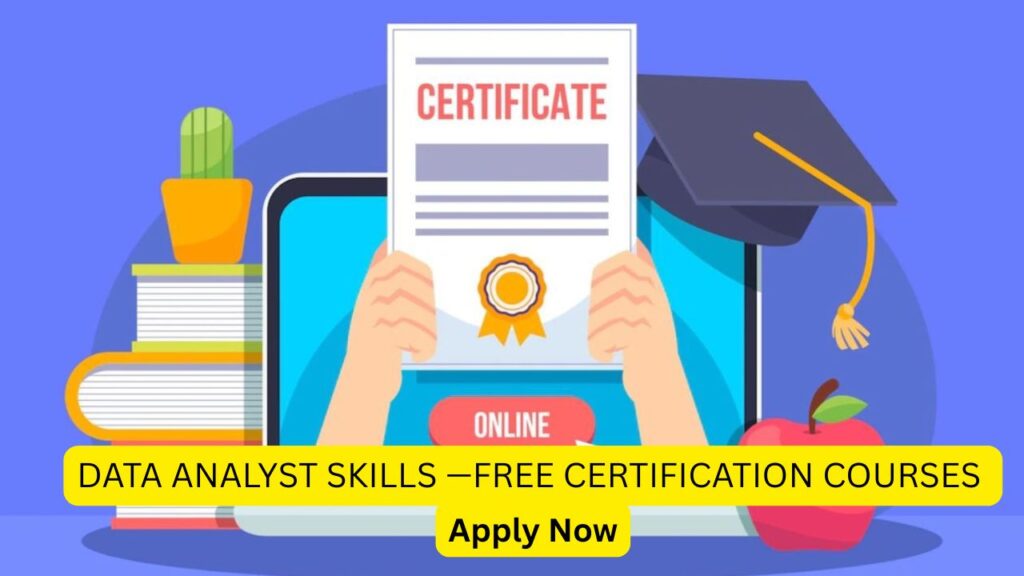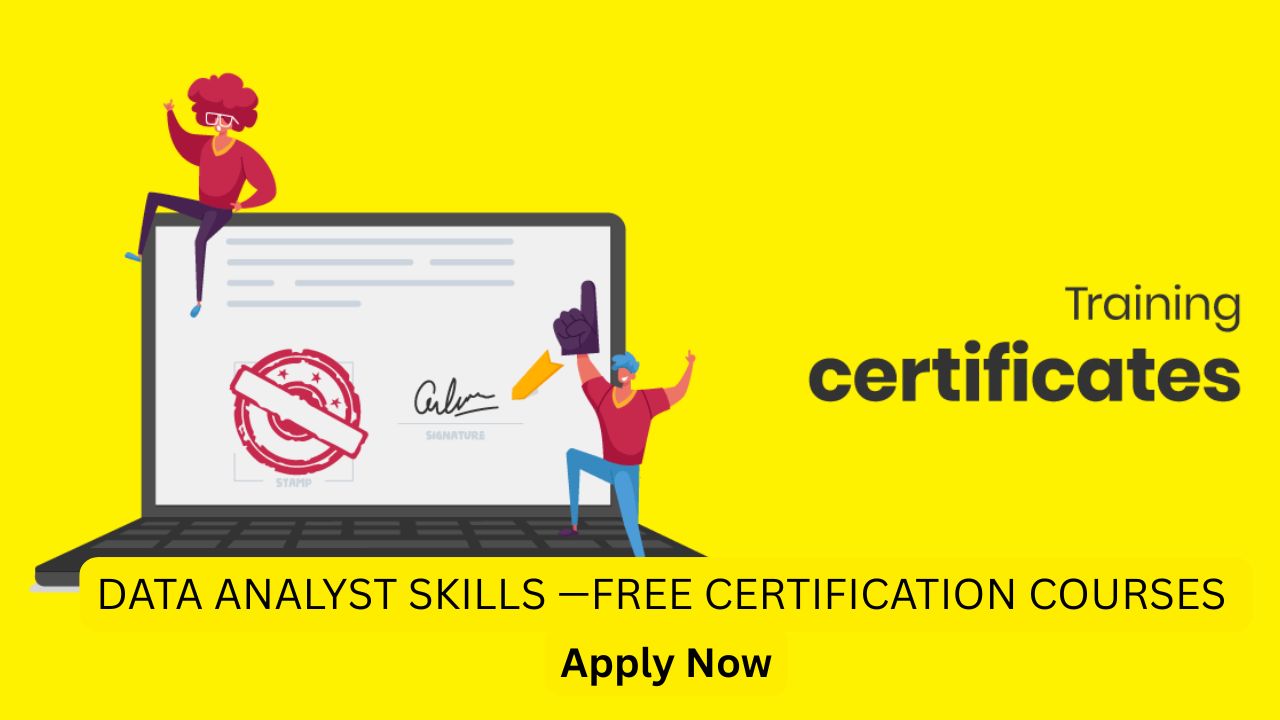If you’re aiming to build a career (or level up) as a data analyst, one of the smartest moves is to take advantage of free certification or course options. These help you gain knowledge, build confidence, and show employers you’re serious—without heavy financial investment.
In this article, I’ll cover:
- What to look for in free courses (especially ones that offer certificates)
- Good platforms & examples of courses
- How to pick what’s right for you
- Tips to get the most out of these free options
What to Look For in a Free Data-Analyst Certification Course
Not all “free” courses are equal. To make a meaningful difference to your skills and your CV, watch out for:
- Certificate / Credential
A course that offers a completion certificate (or better, a credential) is more useful than just learning. Employers like seeing something tangible. - Relevant Tools & Skills Covered
Data analysts often use Excel, SQL, Python or R, data visualization tools (Power BI, Tableau, etc.), basic statistics, data cleaning, data visualization. Make sure the course touches at least most of these. - Hands-on / Practical Projects
Theory plus practice is the key. Working on real or simulated datasets, doing visualizations, making dashboards — these solidify learning. - Beginner Friendly, with a Clear Learning Path
If you are new, you might prefer short courses or modules starting with basics. If you already have some skill, look for more advanced or specialized content. - Recognized Platform / Institution
Certificates from well-known universities or companies tend to carry more weight. Also, the course content is often higher quality. - Flexibility & Self-paced Options
Learning at your own pace is helpful, especially if you’re working or studying already.
Good Free Certification & Course Options
Here are several excellent free courses and programs you can use—some with certificates and credentials, others great for learning plus optional certifications.

| Platform / Course | What You Learn / What’s Good About It | Certificate or Credential Offered? |
|---|---|---|
| IBM SkillsBuild | Offers a free learning path for data analysts. You get taught tools, data cleaning, visualization, usage of Python etc. (IBM SkillsBuild) | Yes — digital credentials you can share, recognized by employers. (IBM SkillsBuild) |
| Great Learning Academy | Free data analytics courses, covering Excel, Python, visualization etc. Many short modules. (My Great Learning) | Yes — course completion certificates. (My Great Learning) |
| Coursera (Free course trials / audit mode) | For example, IBM’s Introduction to Data Analytics, Data Analysis with Python, Excel-based courses etc. (Coursera) | Certificate if you pay (or via free trial / financial aid), but you can often audit the content for free. (Coursera) |
| Cisco Networking Academy — Data Analytics Essentials | Fundamental tools, organizing, transforming, visualizing data. Good for beginners. (Cisco Networking Academy) | Usually yes — certificate on completion. (Check for your specific cohort) (Cisco Networking Academy) |
| Microsoft Learn — Learning Path: Data Analytics / Power BI | Modules to help you learn Power BI, telling stories with data, reports, dashboards etc. (Microsoft Learn) | Yes — often “achievement” or “learning path” certificates. May help prepare for Microsoft’s paid certification. (Microsoft Learn) |
| Springboard — Free Data Analytics Course | This is good for beginners: includes visualization, statistics, basics of ML, tools like Excel, Python, Tableau etc., plus a case study. (Springboard) | It gives training and knowledge; the free version may have certificate of completion type. Check details. (Springboard) |
How to Pick the Right Course for You
Everyone’s background and goals are different. These are some decision points to help you choose:
- Your current level
- If you are just starting, go for courses that begin with basics like “What is data analysis?”, Excel fundamentals, introductory statistics.
- If you have some experience, you may skip introductory courses and jump into Python / SQL / tools.
- Tools you want to learn / already know
If your work or interest involves Excel + dashboards, pick courses strong in Power BI or Tableau. If you want to do more programming or data science, courses in Python / R are better. - Time you can commit
Some courses are brief (a few hours), others take weeks. Look at how many hours or weeks they demand. Make sure it fits your schedule. - Certification credibility
If you plan to put the certificate on your CV / LinkedIn, or want it assessed by employers, then platforms backed by big names (Microsoft, IBM, etc.) often help more. - Cost of certificate (if free content, paid cert)
Sometimes content is free but obtaining the certificate is paid. Make sure to check if the free version gives certificate or whether there’s a nominal cost. If you can’t afford, courses with financial aid or free credentails are good.
How to Make the Most of Free Courses
Here are strategies so you’ll not just finish, but actually gain value:
- Create a learning schedule: Even if the course is self-paced, fix regular slots (1-2 hours a day or so). Consistency helps retention.
- Work on your own projects: Use sample datasets (many are available publicly), try to analyze real data. Build portfolio pieces—dashboards, reports. These are things you can show to potential employers.
- Document what you learn: Maintain notes, blog posts, or even record your process (GitHub if coding). It helps reinforce learning and also acts as proof.
- Participate in communities: Forums, study groups, online communities (on Slack, Discord, StackOverflow, etc.). If stuck, you get help; explaining to others also helps your understanding.
- Combine multiple courses: One course may cover statistics well; another may cover tools like Tableau or SQL. You can stitch together your learning path.
- Always apply: Whenever you learn a concept (say data cleaning, normalization, or visualization), try to apply it in some small task. The doing cements theory.

Potential Free Course Ideas & Suggestions (Sample Paths)
Here are a few sample “paths” depending on your current level / what you want to do.
Path A: If you are completely new
- Free course on “What is Data Analytics” + basic Excel / spreadsheets
- Intro to statistics (mean, median, distributions, variance)
- Visualizing data (charts, dashboards, basic tools like Power BI or Tableau)
- Free course on “Python for Data Analysis” basics: variables, loops, lists, pandas etc.
- Small project: get some public data (e.g. COVID data, or open-government data) and make a report or dashboard.
Path B: If you have some basics and want to improve / specialize
- SQL / databases course (join, filter, aggregation)
- Python / R for data cleaning + manipulation + visualization
- Machine learning basics (regression, classification)
- Tools: build dashboard using Power BI or Tableau, or learn Git / version control
- Case study or capstone: find a problem (business, social, environment) and try to solve it; present your findings.
Challenges & What to Watch Out For
Even good free courses have limitations.
- Sometimes no real assessment or projects → certificates may mean less. So try to supplement with your own work.
- Free certification may not be as “strong” in employer eyes as paid ones, especially if the certificate is not backed by a recognized institution.
- Some courses charge a fee for the certificate even if learning is free. Make sure what “free” means in that context.
- Not all courses keep content updated. Tools and best practices (libraries, software) evolve fast in data analysis / data science.
- Without mentorship / community, it’s easy to get stuck or lose motivation.
Final Thoughts:-
Free certification courses are an excellent stepping stone into the field of data analytics. They let you:
- Try out different tools and see what you like
- Get the basics down without large investment
- Build something tangible for your resume / portfolio
If you pair certifications with real projects (even small ones), continuous learning, and good documentation of your journey, you can often get job-ready with free resources alone.
